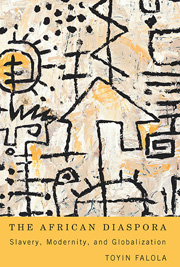Book contents
- Frontmatter
- Dedication
- Contents
- Preface and Acknowledgments
- Introduction: The Old and New African Diaspora
- Part 1 The Old Diaspora: Slavery and Identity Politics
- 1 Africa and Slavery in a Transnational Context
- 2 The Slave Mutiny of 1839: The Colonization of Memory and Spaces
- 3 The Centralization of Africa and the Intellectualization of Blackness
- 4 Communalism, Africanism, and Pan-Africanism
- Part 2 An African Case Study: Yoruba Ethnicity in the Diaspora
- Part 3 The New Diaspora: Transnationalism and Globalization
- Postscript: United States Foreign Policy on Africa in the Twenty-First Century
- Notes
- Bibliography
- Index
2 - The Slave Mutiny of 1839: The Colonization of Memory and Spaces
from Part 1 - The Old Diaspora: Slavery and Identity Politics
Published online by Cambridge University Press: 05 September 2013
- Frontmatter
- Dedication
- Contents
- Preface and Acknowledgments
- Introduction: The Old and New African Diaspora
- Part 1 The Old Diaspora: Slavery and Identity Politics
- 1 Africa and Slavery in a Transnational Context
- 2 The Slave Mutiny of 1839: The Colonization of Memory and Spaces
- 3 The Centralization of Africa and the Intellectualization of Blackness
- 4 Communalism, Africanism, and Pan-Africanism
- Part 2 An African Case Study: Yoruba Ethnicity in the Diaspora
- Part 3 The New Diaspora: Transnationalism and Globalization
- Postscript: United States Foreign Policy on Africa in the Twenty-First Century
- Notes
- Bibliography
- Index
Summary
The 1839 mutiny now known as the Amistad rebellion is an important episode in the history of slave resistance. This chapter shows how that event transmuted into a permanent historical symbol and then into a template to understand race relations over time. I examine not the rebellion itself but how the interpretation of the events reveals our understanding of power and race relations.
The story is already so well known that I shall present only the basic details here. On board the Amistad slave ship, traveling the high seas toward the northeast coast of America from Havana, Joseph Cinqué, one of the enslaved Africans, organized a bloody revolt against the Spanish crew. The temporarily liberated slaves hoped to sail the Amistad back to Africa. However, the Africans had no detailed knowledge of navigation and relied on one of the slave dealers, Montes, who had bought them. Perhaps Montes engaged in a deliberate trick. During the day, he steered the ship toward the east and at night toward the United States.
The ship was subsequently intercepted by the US Navy, which brought it to shore at Long Island, New York. The Amistad and its African cargo were then taken to New London, Connecticut. The Africans were jailed in New Haven, and a judicial hearing was set for August 1839. A trial ensued and exposed tensions between not only nations but also individuals in support of and against slavery.
- Type
- Chapter
- Information
- The African DiasporaSlavery, Modernity, and Globalization, pp. 53 - 71Publisher: Boydell & BrewerPrint publication year: 2013



